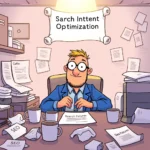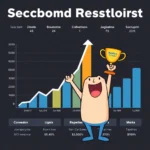The Tale of Bloggy McPostface and the Quest for Search Intent Optimization
Once upon a time, in the bustling digital kingdom of Blogosphere, there lived a humble blogger named Bloggy McPostface. Bloggy wasn’t your average content creator—he had big dreams of making his blog the go-to destination for everything from DIY cat hammocks to the latest in AI-powered toasters. But alas, despite his best efforts, his posts were lost in the vast wilderness of the internet, buried on page 10 of Google’s search results.

One fateful day, while sipping his third cup of overpriced oat milk latte, Bloggy stumbled upon an ancient scroll titled "The Art of Search Intent Optimization." It was rumored to hold the secrets to aligning content with what users actually wanted. Bloggy’s eyes lit up. “This is it!” he exclaimed, startling a nearby barista. “This is how I’ll achieve internet profit success!”
And so began Bloggy’s epic journey to master the mystical art of search intent optimization.
Chapter 1: The Four Houses of Search Intent

Bloggy’s first challenge was to understand the four houses of search intent: Informational, Navigational, Commercial, and Transactional. Each house represented a unique purpose behind a user’s search query.
• Informational Intent: These users were knowledge seekers. They typed things like “How do I make sourdough bread?” or “What is quantum entanglement?” They didn’t want to buy anything—they just wanted answers.
• Navigational Intent: These travelers knew exactly where they wanted to go but needed directions. Think “Facebook login” or “Apple customer support.”
• Commercial Intent: These were the researchers. They weren’t ready to buy yet but were comparing options, like searching for “best noise-canceling headphones 2025.”
• Transactional Intent: Ah, the holy grail! These were the shoppers ready to whip out their credit cards with queries like “buy iPhone 15 online.”
Bloggy realized that his blog posts were like a buffet serving everything at once—great for variety but terrible for satisfying specific cravings. He needed to tailor each post to align with one clear intent.
Chapter 2: The Keyword Crystal Ball
To align his posts with user intent, Bloggy needed to master keyword research. He dusted off his trusty keyword tool and began deciphering what people were searching for.
“Keywords are like breadcrumbs,” he mused. “They lead me straight to what users want.” For example:

• A query like “how to bake cookies” screamed informational intent.
• Meanwhile, “best cookie brands” hinted at commercial intent.
• And “buy chocolate chip cookies near me” was pure transactional gold.
Bloggy also learned that Google wasn’t just looking at keywords anymore—it was analyzing behavior. If users clicked on his post and immediately bounced back to the search results, it meant he’d failed to meet their expectations. This was serious business.
Chapter 3: Spying on Google’s Favorites

Bloggy decided it was time for some reconnaissance. He typed in keywords related to his niche and studied the top-ranking pages.
“What format dominates?” he wondered aloud. For informational queries, he noticed long-form guides and how-to articles ruled the roost. For transactional queries? Product pages and e-commerce sites reigned supreme.
Google wasn’t shy about showing what it liked—it practically handed him a cheat sheet via its top results and features like “People Also Ask.” Bloggy took notes furiously.
Chapter 4: Writing with Purpose (and a Dash of Humor)
Armed with insights, Bloggy began crafting content that perfectly matched user intent:
• For informational posts, he wrote detailed guides peppered with FAQs straight from Google’s “People Also Ask” box.
• For commercial intent, he created comparison articles like “Top 5 AI Toasters That Actually Work.”

• For transactional intent, he optimized product pages with clear calls-to-action and glowing customer reviews.
He even added visuals—snazzy infographics and videos—to keep users engaged longer. And let’s not forget those catchy titles! Bloggy learned from experts that titles should spark curiosity while sneaking in keywords (e.g., “Why Everyone Is Talking About AI Toasters in 2025”).
Chapter 5: The Meta Description Makeover

Bloggy discovered that meta descriptions were like pickup lines for search engines—short but impactful. He rewrote all his meta descriptions to include keywords and irresistible hooks, boosting his click-through rates faster than you can say "SEO strategies 2025."
Chapter 6: The Internal Linking Labyrinth
Next, Bloggy tackled internal linking. He connected his blog posts like a web of intrigue, guiding readers from one post to another seamlessly. Not only did this improve user experience, but it also helped Google crawl his site more effectively.
“Internal links are like breadcrumbs for robots,” he chuckled as he linked his post on cat hammocks to one about DIY scratching posts.

Chapter 7: Measuring Success (or Lack Thereof)

Finally, Bloggy set up analytics tools to measure his progress. He tracked metrics like dwell time (how long users stayed on a page) and bounce rate (how quickly they left). If something wasn’t working, he went back to tweak it—whether it was adding more visuals or rewriting sections for clarity.
Epilogue: A Happy Ending (and Rankings)
Months later, Bloggy’s efforts paid off. His blog posts climbed the ranks of Google faster than a viral TikTok trend. Traffic surged, conversions skyrocketed, and Bloggy finally achieved internet profit success.
As he sipped another oat milk latte—this time guilt-free—he smiled and whispered to himself: “Search intent optimization isn’t just an SEO strategy; it’s an art form.”

And thus ends the tale of Bloggy McPostface—a legend in the land of content creation who proved that aligning with user intent is the ultimate key to blogging success.
The end… or is it?